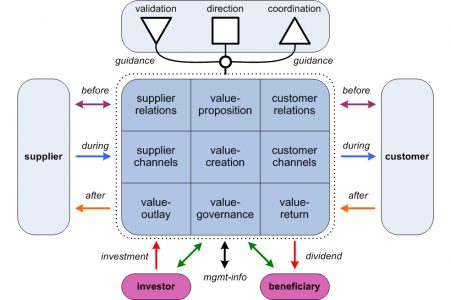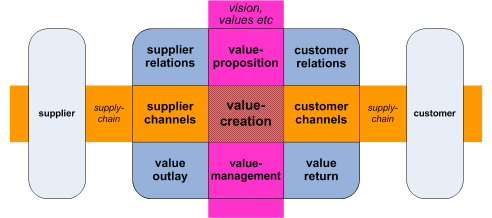Enterprise Canvas for government regulator
A really nice quick-question from David Baxter:
Can Enterprise Canvas be modified for use by a government regulator?
The quick answer is, yes, of course – it’s a generic model for how services of any type interrelate with each other:
Whether it’s government, commercial-industry, NGO or any other context really doesn’t matter all that much, because, ultimately, everything is or represents a service – which means that, at a generic level at least, we can assess them all in exactly the same way. They all have ‘suppliers’ (direct service-providers), ‘customers’ (direct service-consumers); they all have investors and beneficiaries (primarily citizens, in a government context); and they all need guidance to connect them to the bigger picture.
The detail-content is different, of course, but the overall principles are much the same. So we elicit that detail by leveraging the fact that at that generic level, all services are much the same.
For a regulatory context, in terms of how and to whom the regulator’s services are provided, the regulator itself largely acts as a ‘validation-service’ to others. Hence, for example, if we envision a regulation-liable organisation as ‘the service in context’ – the central block in a Enterprise Canvas model – then the regulator has a ‘validation-service’ relationship with that ‘the service-in-context’:
As with every validation-service, our aim is to support some particular value, such as financial-probity, or safe childcare, or protection of environment. For whatever the value is, there are four distinct aspects:
- Develop awareness of the value, and why it’s important
- Develop capability to enact support for that value
- Enact the value within real-time service-delivery
- Validate that appropriate action has been taken, and support continual-improvement
The third aspect always takes place within the service itself; but the first, second and (perhaps especially) the fourth are where a regulator would come into the picture.
The key point is that the whole thing is fractal: each of the services that the regulator delivers, for aspects 1, 2 and 4, are themselves services in their own right – hence the exact same Enterprise Canvas principles and patterns apply for each of those, too.
(Which, by the way, also requires an answer to the classic question “quis custodiet ipsos custodies?”, ‘who watches the watchers?”: even a validation-service itself requires validation-services to ensure that it keeps on-track to whole-enterprise values.)
Being fractal, it’s also recursive: hence each service would itself typically be made up of ‘child-services’, to each of which again all of the same patterns and principles would apply. The default diagram for Enterprise Canvas provides some typical examples of what roles such child-services might take on, though in practice every service will have its own specific quirks and structures. For example, these are typical roles:
And some of the generic labels that we might apply to those roles:
Those are only generic labels, of course: we might use the context-specific label ‘Procurement’ for the generic ‘Supplier relations’ child-service, for example, or ‘Accounts Payable’ for the generic ‘Value Outlay’. And specific services might instead split up their internal structures in completely different ways: the default Enterprise Canvas layout is just to provide something with which to start discussion, and also a checklist to ensure that key concerns are not missed out.
We’d explore this to whatever depth might be needed, governed by those key architectural principles ‘It depends…’ and ‘Just enough…’.
One other important point. When we talk about ‘the enterprise’ here, we don’t solely mean ‘the organisation’ – we mean the whole shared-enterprise within which that organisation operates:
Hence, for example, for a government regulator as ‘the organisation’, its ‘customers’ are the organisations to which it provides regulatory and compliance services; but its ‘market’ is determined by Parliament, for example, together with the media, research-bodies and suchlike; and the broader shared-enterprise includes all citizens of the country, and often – for a regulator – other more-distant stakeholders in other countries too.
I hope that gives something to start with? – happy to explore this further with anyone, anyway, if and as required. 🙂
Over to you all for comments and suggestions, as usual?





Leave a Reply